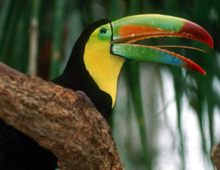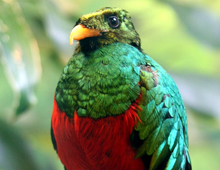Birds of El Triunfo

Keel-billed toucan, Ramphastos sulfuratus
Also known as the Rainbow-billed or Sulfur-breasted toucan, it is popular for its resemblance to “Toucan Sam™”, the “Froot Loops®” mascot. The northernmost of the large toucans, it ranges from the Mexican state of San Louis Potosi south to Colombia and Venezuela. Much habitat has been lost to agriculture. Though first hatched in captivity at the Houston Zoo, in 1974, it has not bred consistently in collections. The DWA is involved in a captive breeding consortium for this species involving both private collections and public zoos.
LEARN MORE
Quetzals, Pharomachrus
The Mayans and Aztecs demanded rare tribute from their subject peoples. The feathers of quetzals were prized more than gold. The five species of quetzals are specialized trogons, found from Mexico south to Bolivia and Brazil. The three species that are part of the collection at the DWA are: Golden-headed quetzal (Pharomachrus auriceps), Crested quetzal (Pharomachrus antisianus) and the Resplendent quetzal (Pharomachrus mocinno). All are green and red, but only the Resplendent quetzal, of Mexico and Central America, bears the prized long plumes.
LEARN MORE
Harpy eagle, Harpia harpyja
A top-of-the-food chain predator, this enormous bird is not abundant anywhere in its vast range from the Mexican States of Veracruz and Oaxaca south to Argentina, Bolivia, and Southern Brazil. A specialist in eating sloths and monkeys, it depends on extensive forest, so is considered Near-Threatened due to habitat loss. Females may exceed 20 pounds in weight. Probably kept by Montezuma, it was displayed in Europe as early as 1778. The first successful captive breeding did not occur until 1981. The female displayed at the DWA hatched at the San Diego Zoo.
LEARN MORE

